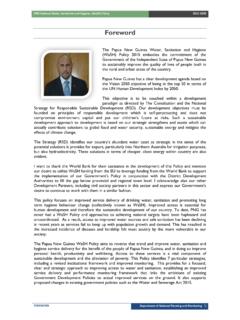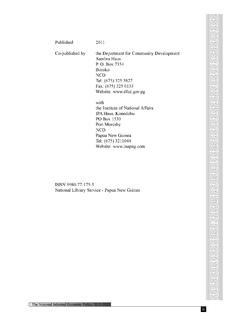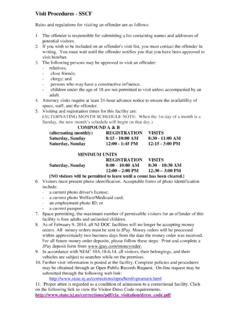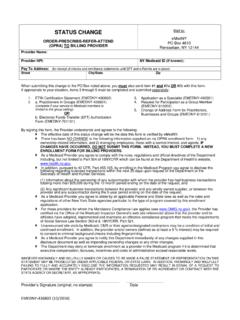Transcription of A Critical Analysis of Agriculture Extension Services in ...
1 A Critical Analysis of Agriculture Extension Services in Papua New Guinea: Past, Present and Future CIMC National Agriculture Conference Theme: Key Drivers for a Robust, Dynamic and Productive Agriculture Sector in PNG 24-25 May 2012 NARI Multi Purpose Hall, Bubia, Lae 2 Table of Contents 1. Introduction .. 3 2. History of Agricultural Extension 4 Pre-Independence Period .. 4 Post-Independence Period .. 5 The decentralization process .. 5 The corporatization of the agricultural sector.
2 5 3. Current Status of Agricultural Extension in PNG .. 8 Extension agencies and rural advisory service providers .. 8 Funding of 8 Extension personnel .. 9 Extension 9 Technology transfer .. 9 Human resource development approach .. 11 Private sector assisted delivery .. 12 Participatory or farmer-demand driven 13 4. The Need for Reform in Agriculture Extension and Rural Advisory Services in PNG .. 14 The Challenges to Extension Reform in PNG .. 14 A New Agricultural Extension Policy.
3 18 A National Coalition of Extension and Rural Advisory Service Stakeholders .. 21 Figure 1: Extension and Rural Advisory Service Stakeholders in PNG .. 23 24 Annex 1: Public and Private Extension Agencies in Papua New Guinea .. 26 Annex 2: Estimated Budget Support for Agriculture Extension , 2010 .. 27 Annex 3: Number of Agricultural Extension Personnel in the Public Sector, 2011 .. 28 3 A Critical Analysis of Agricultural Extension Service in Papua New Guinea: Past, Present and Future By Sitapai1 1.
4 Introduction Agricultural Extension is a functional system of applying scientific research results and new knowledge to agricultural practices through farmer education (van den Ban & Hawkins, 1996). The process involves the conscious use of communication of information to help rural peoples form sound opinions and make good decisions on how to improve their production methods and techniques so as to increase farm efficiency and income, and to enhance their levels of livelihoods, and social and education standards.
5 Today, the field of agricultural Extension is more complex and encompasses a wider range of communication and learning activities organized for rural communities by different disciplines, such as agricultural education, agri-business and marketing, agricultural engineering, mass communication, health and environmental sciences. In Papua New Guinea (PNG), the complexity in the agricultural Extension service has evolved with political, administrative, and institutional reforms over the last fifty years (Sitapai, 2011).
6 Commencing as a single line central government function in the 1950s and 1960s, the agricultural Extension service is presently a shared responsibility of the three-tiers of Government as well as statutory commodity boards, semi- or quasi-government organizations. However, despite the institutional complexity of service providers, the Extension service is industry specific and supply-driven, with a primary focus on increasing production of cash crops. The Extension service is also highly dependent on public funding.
7 Hence, with the declining Government budgetary support over the years, the quality of the service has deteriorated, with limiting coverage nation-wide. The state of decline in the quality of agricultural Extension service in PNG has been extensively reviewed over the last twenty years. The Asian Development Bank (ADB) studies in the early 1990s recommended further institutional reforms for research and Extension in PNG (ANZDEC, 1993). Subsequent reviews by the National Department of Agriculture and Livestock (NDAL) in the late 1990s (McKillop, 1994) and early 2000s (GOPNG, 2000) led to a National Extension Summit in 2004 (Dekuku , 2005).
8 This paper presents an account of the evolution of agricultural Extension prior to, and since Independence, including an Analysis of the current status of Extension service providers. It also outlines a process of reform as a way forward in mobilizing the potential of the rural advisory Services , and as an effective tool for achieving agricultural and rural development. The paper concludes that this reform will be best aided by a new and robust Extension policy, promoted by a national advocacy mechanism for Extension stakeholders in PNG.
9 1 Address: Pacific Agri-Systems Limited, Box 534, Port Moresby, NCD, PNG. Email: Much of the information for this paper was collated in a 2011 study for NARI & the ACP-EU Technical Centre for Agriculture and Rural Cooperation (CTA). 4 2. History of Agricultural Extension Services Pre-Independence Period The agricultural Extension service has a history dating back to the late 1930s with the advent of plantation Agriculture (Dennis, 1981).
10 After the 2nd World War, the early Administration commenced the rehabilitation of the Agriculture sector, under a colonial policy of developing an export-oriented economy based on selected perennial tree crops. As part of this effort, the Administration, through its colonial Department of Agriculture Stock and Fisheries (DASF) commenced a network of agricultural experiment stations in the 1950s, located at strategic position in the country. The research facilities were established in the Central, East New Britain, Morobe, Eastern Highlands and Western Highlands Provinces.













